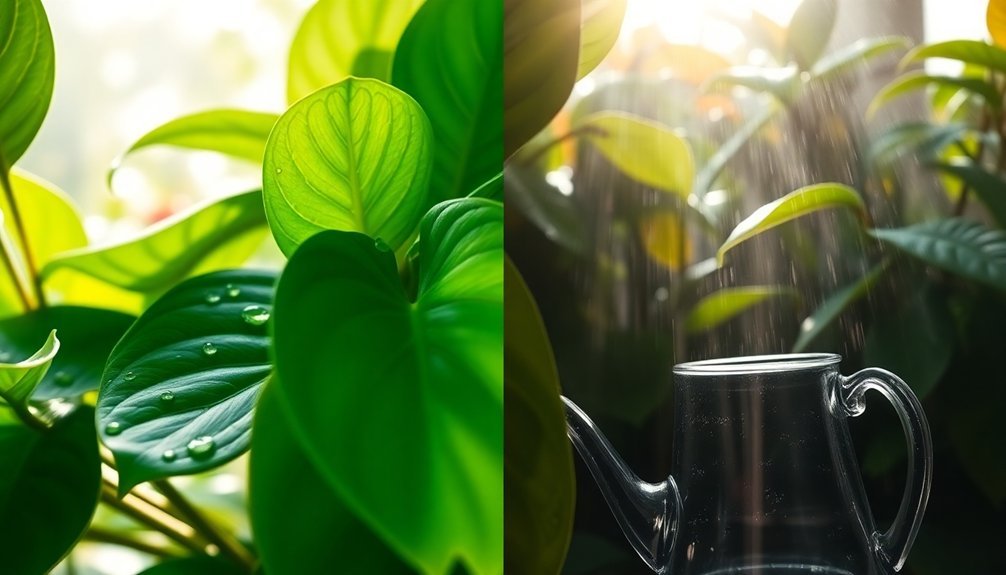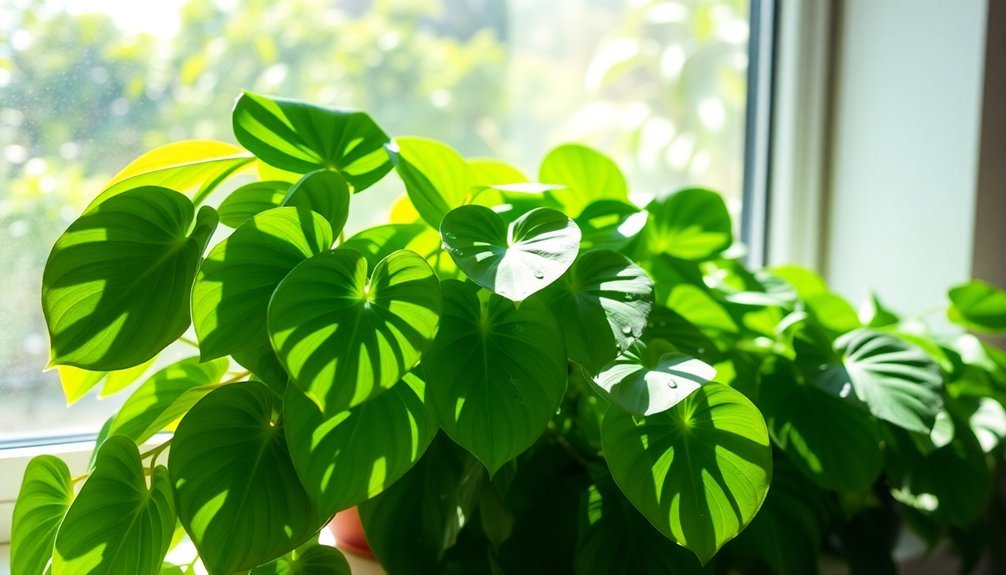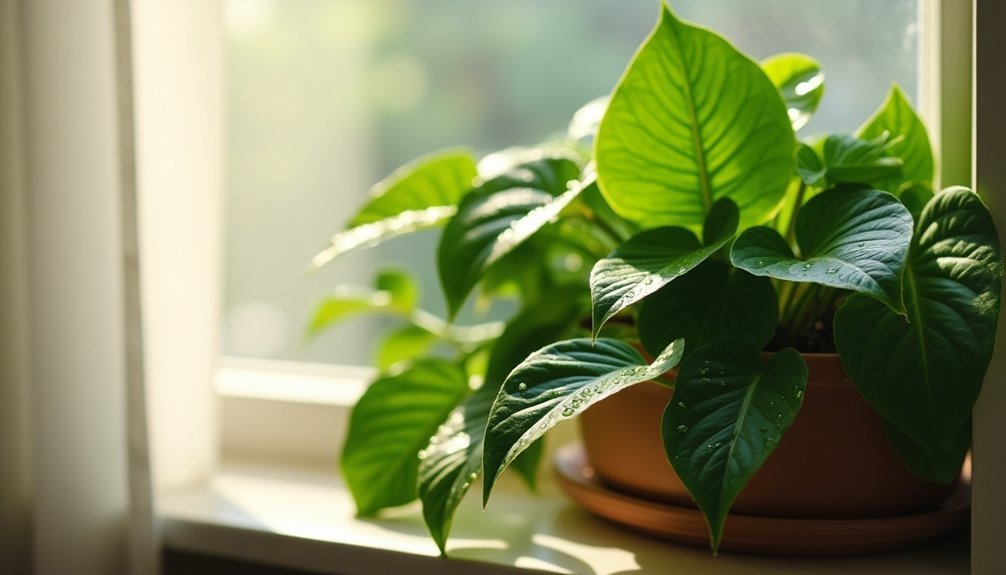Your philodendron needs bright, indirect light and will thrive near east or west-facing windows with filtered sunlight. Keep it a few feet back from strong light sources and watch for leggy growth, which signals it needs more brightness. Water thoroughly when the top inch of soil feels dry, adjusting frequency seasonally – more in summer, less in winter. Getting these two factors right makes up 80% of successful philodendron care, but there's much more to mastering their growth.
Natural Light Requirements for Thriving Philodendrons

While Philodendrons naturally grow beneath dense rainforest canopies, they thrive in bright, indirect light in home environments. Chlorophyll absorption helps these plants efficiently process filtered light in their native habitats.
To mimic these conditions, place your plant near east or west-facing windows if you're in the Northern Hemisphere, or a south-facing window with filtered light in the Southern Hemisphere.
You'll need to protect your Philodendron from direct sunlight, which can scorch its leaves and cause yellowing.
If you're using south or west-facing windows, hang sheer curtains or position the plant a few feet away from the window.
During summer, move your plant further from the window to avoid intense light, while in winter, bring it closer to maximize exposure to weaker sunlight.
For rooms with limited natural light, you can supplement with LED grow lights positioned 12-18 inches above the plant.
Understanding Light Intensity and Measurement
Getting the right amount of light for your Philodendron means understanding how to measure it properly. You'll need at least 400 foot-candles (4,000 lux) for ideal growth, though your plant can survive with as little as 100 foot-candles. For accurate light measurement, point the sensor upward towards the light source rather than at the plant.
| Light Level | Measurement | Plant Response |
|---|---|---|
| High | >400 ft-candles | Healthy growth |
| Medium | 200-400 ft-candles | Moderate growth |
| Low | 100-200 ft-candles | Slow growth |
| Too High | Direct sun | Leaf burn |
| Too Low | <100 ft-candles | Leggy growth |
You can measure light intensity using a light meter ($35) or a smartphone app like Photone. If you don't have these tools, try the shadow test – crisp shadows indicate bright light, while faint shadows suggest lower light conditions. Remember to check light levels throughout the day, as they'll fluctuate with the sun's position.
Identifying the Perfect Window Placement

Where you place your philodendron can make or break its growth success. East-facing windows are your best bet, offering bright morning sun and gentle indirect light throughout the day. You'll want to position your plant directly in front of these windows for ideal growth. A stable temperature between 16 to 30 degrees Celsius is crucial for healthy development.
For other window orientations, you'll need to make specific adjustments:
- North-facing: Place directly next to the window to maximize indirect light
- South-facing: Keep a few feet back and use sheer curtains to filter harsh rays
- West-facing: Position away from direct exposure and filter afternoon sun
Remember to adjust your plant's placement as seasons change. During summer, move it further from windows to avoid intense heat, while winter calls for closer proximity to light sources.
If natural light isn't enough, consider adding grow lights 12-18 inches above your plant.
Signs Your Philodendron Needs More Light
Several telltale signs can alert you to insufficient light for your philodendron. You'll notice leggy growth, where stems become elongated while leaves stay small. The plant's overall growth slows down, and leaves may appear paler than usual with increased spacing between them.
| Sign | What to Look For |
|---|---|
| Growth Pattern | Stretched stems, smaller leaves |
| Leaf Changes | Pale color, wider spacing |
| Plant Behavior | Leaning toward light source |
If you spot these symptoms, it's time to take action. Move your philodendron to a brighter spot or consider adding grow lights that provide 2000-3000 lumens per square foot. Monitor your plant's response to the new lighting conditions, and adjust seasonally as natural light levels change throughout the year.
Water Requirements Through Different Seasons

While proper lighting sets the foundation for healthy philodendrons, mastering their water requirements will keep them thriving year-round.
You'll need to adapt your watering routine as seasons change, giving more water during spring and summer when your plant is actively growing, and less during fall and winter's dormant period.
During the growing season, check the top inch of soil weekly, watering thoroughly when it feels dry. In cooler months, reduce watering frequency to prevent root rot.
Consider these key factors that affect how often you'll need to water:
- Light exposure level – brighter spots need more frequent watering
- Your home's humidity and heating conditions
- Pot size and material – smaller or terra cotta pots dry faster
Always water deeply until it drains, but never let your plant sit in standing water.
Mastering the Art of Proper Watering Techniques
To maintain healthy philodendrons, you'll need to master proper watering techniques that go beyond simply adding water to the pot. Check the top inch or two of soil with your finger – when it feels dry, it's time to water.
You can water your philodendron from either the top or bottom. Top watering works best after repotting and helps flush out mineral buildup, while bottom watering encourages stronger root development.
Whichever method you choose, guarantee proper drainage to prevent waterlogging.
Watch for warning signs: drooping or yellowing leaves might indicate either too much or too little water. If the soil is shrinking and leaves have brown edges, you're underwatering.
If you notice fungal growth or stem rot, you're likely overwatering. Adjust your watering frequency based on your plant's size, environment, and soil composition.
Creating the Ideal Humidity Environment

When it comes to maintaining ideal humidity for your philodendron, you'll need to choose between quick-fix methods like misting and more sustainable solutions such as humidity trays.
You can boost moisture levels naturally by grouping your plants together, creating a micro-environment that benefits from their collective transpiration.
For consistent results, position a humidifier near your philodendron while ensuring proper air circulation to prevent stagnant conditions that could lead to fungal issues.
Misting vs. Humidity Trays
Creating the right humidity level for your philodendron presents a common dilemma: should you mist the leaves or use a humidity tray? While misting might seem like an easy solution, it's actually less effective than you'd think. Water droplets evaporate within 15 minutes, and frequent misting can promote fungal growth.
Humidity trays offer a more practical and sustainable solution. Here's why they're superior:
- They provide continuous moisture through natural evaporation
- They're low-maintenance, requiring only periodic water refills
- They pose minimal risk of fungal or bacterial problems
For your Philodendron Selloum, which needs 60-80% humidity, a pebble tray will help maintain ideal levels. Simply fill a tray with pebbles, add water below the stones' surface, and place your plant on top.
You'll create a stable moisture environment without the risks associated with misting.
Natural Moisture Enhancement Methods
Beyond humidity trays and misting, several natural methods can effectively boost moisture levels for your philodendron.
Group your plants together to create a micro-humid environment through transpiration, mimicking their natural rainforest habitat. This strategy works particularly well when you position your philodendron near other moisture-loving plants.
You'll want to maintain temperatures between 65-80°F to support ideal humidity levels. Keep your plant away from heating vents and radiators, which can dry out the air.
Use a hygrometer to monitor humidity, aiming for 60-80% during the day and 55% at night. Watch for signs of low humidity, such as brown leaf edges or wilting.
Remember to guarantee proper air circulation while grouping plants to prevent fungal issues from excessive moisture.
Humidifier Placement Tips
Proper humidifier placement plays an essential role in maintaining ideal humidity for your philodendron. Position your humidifier in the same room as your plants, but keep it a few feet away to prevent moisture condensation on the leaves. For best distribution, elevate the device off the ground and place it centrally in the room.
When setting up your humidifier, follow these key distance guidelines:
- Cool-mist units: Keep at least 1 foot away from plants
- Large-capacity models: Maintain 6 feet of distance
- Steam humidifiers: Position even further to avoid leaf damage
Use the lowest effective setting and monitor humidity levels with a hygrometer, aiming for 60-80% during the day and 55% at night.
Choose distilled water over tap water to prevent mineral buildup, and clean your unit regularly to avoid mold growth.
Common Light and Water Issues to Watch For
Watch for key signs of light issues in your philodendron, including scorched leaves from too much direct sun, leggy growth from insufficient light, and pink discoloration from intense artificial lighting.
You'll know you've got watering problems if you spot drooping leaves, yellowing foliage, or mushy stems that indicate potential root rot.
These common problems are easy to spot early and correct by adjusting your plant's light exposure or tweaking your watering routine.
Signs Of Light Problems
Recognizing light problems early in your philodendron can prevent lasting damage and guarantee healthy growth. When your plant isn't getting enough light, you'll notice leggy growth with sparse leaves, and stems stretching toward light sources. The leaves may also appear lighter in color and smaller than usual.
Too much light can be just as problematic. Watch for these clear warning signs:
- Crispy, brown edges on leaves
- Yellowing foliage that drops frequently
- Bleached or discolored leaf surfaces
You'll get the best results by placing your philodendron in bright, indirect light, typically near east or west-facing windows.
If natural light isn't sufficient, consider installing LED grow lights that provide 2000-3000 lumens per square foot for 12-16 hours daily.
Watering Trouble Indicators
Understanding your philodendron's water needs can be challenging, but the plant will tell you when something's wrong. If you're overwatering, you'll notice yellowing leaves, a musty soil smell, and soft, mushy stems. Water-filled blisters, known as edema, may also appear on the leaves.
Underwatering shows different signs: drooping leaves, crispy brown edges, and soil that pulls away from the pot's sides. If your pot feels unusually light when lifted, it's time to water.
Your plant's watering needs change with its environment. Bright light and warm temperatures increase water demands, while high humidity reduces them.
Don't follow a rigid schedule – instead, check the soil moisture with your finger. When watering, use room temperature water and guarantee proper drainage to avoid root problems.
Adjusting Care Based on Growth Patterns

Successful philodendron care depends on your ability to read and respond to the plant's growth patterns. By monitoring your plant's response to light and water, you'll know when adjustments are needed.
If you notice leggy growth or fading variegation, move your plant to a brighter spot with indirect light, aiming for 50-250 umol/m2/s intensity.
Watch for these key indicators to adjust your watering routine:
- Drooping leaves can signal either over or underwatering
- Yellow leaves often mean you're watering too much
- Wilting or browning new growth suggests underwatering
When you provide ideal conditions, including humidity above 65%, your philodendron will reward you with lush growth and vibrant foliage.
Remember to make any light or location changes gradually to prevent shock to your plant.
Essential Tools for Light and Water Management
Taking the guesswork out of philodendron care starts with reliable tools: a quality light meter to maintain ideal brightness levels of 2000-3000 lumens, and moisture meters to prevent overwatering.
You'll want to invest in a digital hygrometer for humidity tracking and an LED grow light with timer functionality for consistent light cycles of 12-16 hours daily.
A well-equipped care station should also include a watering can with a narrow spout, plus a turkey baster for removing excess water from saucers, ensuring your philodendron gets exactly what it needs to thrive.
Light Meters Worth Having
Three essential light meters stand out for philodendron care, each serving different measurement needs. The silicon photodiode meters offer reliable readings in both foot candles and lux, making them perfect for measuring natural light conditions.
For grow light setups, you'll want a PAR meter to accurately measure the light your philodendrons receive from LED sources.
The Hopoocolor OHSP350P and Extech LT45 are particularly valuable because they offer:
- Spectral analysis capabilities for precise light quality assessment
- Multiple measurement modes for both natural and artificial light
- Easy-to-read displays with instant feedback
When you're using these meters, remember to take measurements throughout the day, positioning the sensor at plant level and facing your light source.
This approach helps you create the perfect light environment that mimics your philodendron's natural habitat.
Best Watering Gadgets Available
Proper watering gadgets streamline philodendron care by automating moisture delivery and reducing common watering mistakes.
You'll find self-watering pots particularly useful, as they feature reservoirs and float systems that maintain consistent moisture levels while preventing overwatering.
For precise control, opt for watering cans with narrow spouts that let you target the soil directly without wetting the foliage.
If you're concerned about root health, breathable pots with ventilation holes promote proper airflow and drainage, preventing root rot.
Consider waterwick technology for a low-maintenance solution.
These systems let your philodendron draw water as needed, ensuring stable moisture levels without your constant attention.
When combined with appropriate soil mix, these gadgets help create ideal growing conditions while saving you time and effort.
Humidity Monitoring Made Simple
Beyond watering gadgets, successful philodendron care depends on maintaining ideal humidity and light conditions.
While these tropical plants naturally thrive in 80% humidity, they'll adapt well to typical household levels between 40-60%.
To monitor and maintain favorable conditions, you'll need reliable tools. Smart sensors and digital hygrometers offer real-time readings that update every 10 seconds, helping you track your plant's environment precisely.
The most effective monitoring solutions include:
- IoT sensors like the EarthOne Plant Monitor for thorough tracking
- Digital hygrometers for accurate humidity readings
- Smart humidifiers with app control for remote adjustments
Keep historical MIN/MAX humidity records to fine-tune your plant's environment over time.
When paired with proper light management – bright indirect light without direct sun exposure – you'll create the perfect conditions for your philodendron to flourish.
Seasonal Care and Environmental Adaptations

While philodendrons can adapt to various indoor conditions, they still require specific seasonal adjustments to thrive throughout the year. You'll need to modify their care routine based on natural light changes and temperature fluctuations across seasons.
| Season | Light Needs | Care Adjustments |
|---|---|---|
| Spring | Increase exposure | Resume fertilizing, monitor new growth |
| Summer | Protect from direct sun | Increase humidity, regular watering |
| Winter | Add grow lights | Reduce watering, maintain warmth |
Understanding your philodendron's natural habitat helps you create ideal growing conditions. These plants evolved in tropical rainforests, growing under tree canopies with filtered light and high humidity. They've developed aerial roots for climbing and nutrient absorption, and their leaves adapt in size and shape as they mature. Maintain temperatures between 65-80°F and keep them away from drafts or heating vents.
Frequently Asked Questions
Can I Grow Philodendrons Under Artificial Light Only?
Yes, you can grow philodendrons successfully under artificial light alone. You'll need full-spectrum LED grow lights positioned 12-18 inches above your plants, running 12-16 hours daily to provide adequate light for healthy growth.
Do Variegated Philodendrons Need Different Light Than Regular Ones?
Yes, you'll need to give variegated philodendrons slightly brighter indirect light than regular ones because they have less chlorophyll. Just be careful not to expose them to direct sun, which can burn leaves.
Will Hard Water Affect My Philodendron's Health?
Yes, hard water can harm your philodendron's health. It'll cause mineral buildup in the soil, leading to nutrient deficiencies and leaf damage. You'll want to use filtered, distilled, or rainwater for best results.
Can Philodendrons Grow in Water Permanently Without Soil?
Yes, you can grow philodendrons permanently in water. You'll need to maintain proper nutrients through monthly fertilization, change water regularly, and guarantee clean water conditions. Your plant will adapt to hydroponic growing conditions.
How Do Air Conditioners and Heaters Affect Philodendron Watering Needs?
When you run heaters or AC, you'll need to water your philodendron more frequently as both systems dry out the air. Check soil moisture daily and consider using a humidity tray to offset these effects.
In Summary
Your philodendron's success depends on balancing its light and water needs. You'll know you're on track when you see steady growth, healthy leaves, and strong stems. Keep monitoring your plant's response to its environment, and don't hesitate to adjust its position or watering schedule when needed. With the right attention to these basics, you'll enjoy a thriving philodendron that brightens your space for years to come.
References
- https://intuitiveplants.org/blogs/houseplants-light-101/philodendron-light-requirements-a-comprehensive-guide
- https://www.plantsforallseasons.co.uk/blogs/philodendron-care/how-often-should-you-water-a-philodendron
- https://www.thespruce.com/how-often-to-water-philodendron-8705467
- https://cafeplanta.com/a/blog/understanding-the-light-needs-of-philodendron-a-comprehensive-guide
- https://orangelakenursery.com/blogs/orange-lake-nursery-blog/shedding-light-on-philodendron-care-finding-the-perfect-grow-lights
- https://bloomscape.com/plant-care-guide/philodendron/
- https://plantaddicts.com/philodendron-sunlight-requirements/
- https://www.ambius.com/resources/blog/plant-profile/philodendron-plant-care
- https://greeneryunlimited.co/blogs/plant-care/how-to-measure-light-for-plants
- https://florasense.com/blogs/philodendron-light-requirements/
- https://growlightmeter.com/the-best-light-meter-app-for-plants/
- https://jomostudio.com/blogs/plant-with-jomo/your-complete-pink-princess-philodendron-care-guide
- https://www.finegardening.com/article/how-to-grow-and-care-for-philodendrons
- https://www.plantsforallseasons.co.uk/blogs/philodendron-care/philodendron-problems-to-look-out-for-and-how-to-solve-them
- https://www.ukhouseplants.com/plants/philodendron-care
- https://florasense.com/blogs/watering-philodendrons-best-practices/
- https://plantaddicts.com/watering-philodendron/
- https://cafeplanta.com/a/blog/how-often-to-water-philodendron-a-comprehensive-guide
- https://www.merrifieldgardencenter.com/philodendron-care-guide/
- https://philodendroncare.com/what-humidity-levels-are-ideal-for-philodendrons/





Leave a Reply